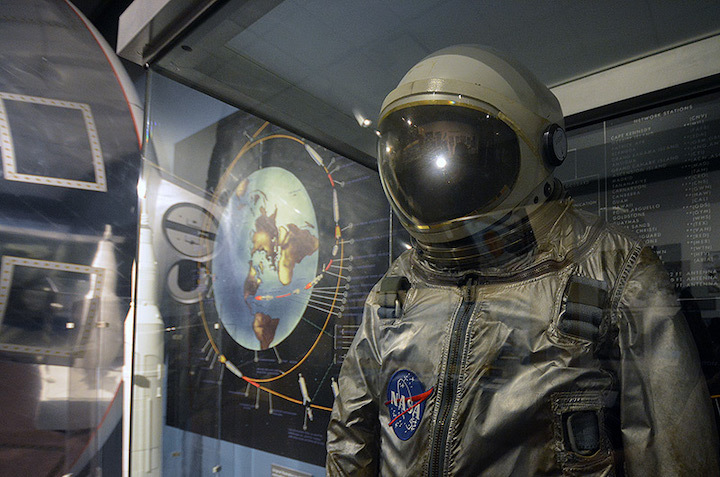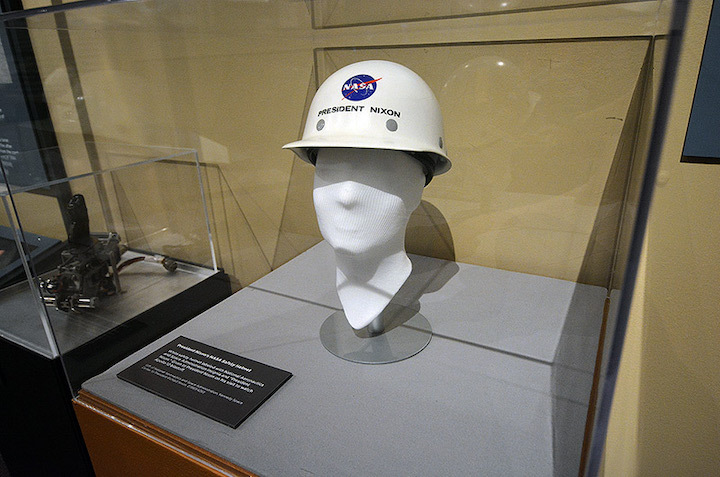Richard Nixon's Apollo 11 artifacts on display at Presidential Library
|
— His signature landed there, he spoke to the astronauts on its surface and now, 50 years later, his museum is exhibiting the history that connects Richard Nixon to the moon. |
 The Richard Nixon Presidential Library and Museum has opened a new exhibit, "Apollo 11: One Giant Leap for Mankind," in recognition of the 50th anniversary of the first moon landing. (collectSPACE)
 A 3-D printed, life-sized statue of Neil Armstrong in his spacesuit stands near a replica of the Apollo 11 plaque that bears President Richard Nixon's signature on the moon. (collectSPACE)
|

|
"Apollo 11: One Giant Leap for Mankind" is now open at the Richard Nixon Presidential Library and Museum in Yorba Linda, California. (collectSPACE)
|

|
The "Apollo 11: One Giant Leap for Mankind" opens with the beginning of the space age and the launch of the first satellite, Sputnik. (collectSPACE)
|

|
President John F. Kennedy set the goal of reaching the moon in 1961, but it was Nixon who was the president when it was achieved. (collectSPACE)
|

|
A drafting desk with schematics for the Apollo lunar module represents the 400,000 people who made the moon landing possible. (collectSPACE)
|

|
The "Apollo 11" exhibit highlights some of the contributions made by California-based companies in the moon landing effort. (collectSPACE)
|

|
A pressure suit worn by X-15 rocket plane pilot Joe Walker represents the similar garment worn by Neil Armstrong prior to his becoming an astronaut. Armstrong, who would go on to command Gemini 8 and Apollo 11, was first a NASA research pilot in southern California. (collectSPACE)
|

|
A large recreation of an Apollo command module, the spacecraft that carried astronauts into lunar orbit and returned them to Earth. (collectSPACE)
|

|
The Apollo 11 crew included commander Neil Armstrong, lunar module pilot Buzz Aldrin and command module pilot Michael Collins. (collectSPACE)
|

|
Apollo 11 lunar module pilot Buzz Aldrin's ACR penlight used during the first moon landing mission. (collectSPACE)
|

|
A NASA safety hat worn by President Richard Nixon during his trip to Kennedy Space Center to see the Apollo 12 launch in 1969. (collectSPACE)
|

|
The exhibit's originally-created, 360-degree virtual reality experience transports visitors to the lunar surface on July 20, 1969, to see and hear Apollo 11 commander Neil Armstrong's "one giant leap for mankind." (collectSPACE)
|

|
A silver-plated model of the Apollo lunar module presented to President Nixon by the spacecraft's contractor, Grumman Aerospace. (collectSPACE)
|

|
Moon rocks from the lunar surface, returned by astronauts during the Apollo 15 and Apollo 17 missions in 1971 and 1972, respectively. (collectSPACE)
|

|
(collectSPACE)
|

|
In January 1970 in the Oval Office, President Nixon held a set of tongs used by astronauts to pick up moon rocks off the lunar surface. (collectSPACE)
|

|
Visitors to the Nixon Library can sit in a living room and watch the moon landing just like people did all over the world 50 years ago. (collectSPACE)
|

|
Oval Office telephone that President Nixon used to call Neil Armstrong and Buzz Aldrin as they explored the lunar surface. (collectSPACE)
|

|
A partial mockup of the mobile quarantine facility that was used to house the Apollo 11 crew aboard the USS Hornet recovery ship. (collectSPACE)
|

|
Presidential Medal of Freedom Award presented to Apollo 11 astronaut Michael Collins by President Richard Nixon in August 1969. (collectSPACE)
|

|
A USS Hornet recovery ship cap and commemorative mug presented to Nixon in commemoration of the Apollo 11 splashdown. (collectSPACE)
|

|
President Richard Nixon's draft speech prepared by William Safire in the event of a "moon disaster" during the Apollo 11 mission. (collectSPACE)
|

|
The Nixon Library's permanent exhibits include Apollo 11 and Apollo 17 spacesuit replicas mounted on a wall above visitors' heads. (collectSPACE)
|

|
Apollo 11 lunar module pilot Buzz Aldrin donned a pair of replica boots and left prints in the concrete outside of the Nixon Library. (collectSPACE)
|

|
"He [Buzz Aldrin] walked here in peace for all mankind, July 1999, 30th anniversary of the Apollo 11 moon landing." (collectSPACE)
|
Quelle: collectSPACE
